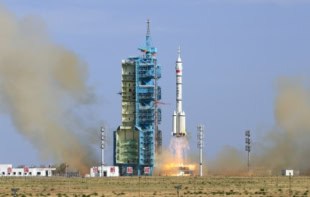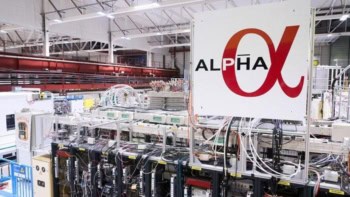
Data collected more than thirty years ago contain what could be evidence of high-energy neutrinos generated by a supernova. That is the claim of Yuichi Oyama, a physicist at the KEK research institute in Japan, who worked on one of two experiments that he says appear to have intercepted such particles from the SN1987A event but which did not release the relevant data at the time. The find could help explain the origin of the most energetic cosmic rays, but other experts reckon the evidence does not stack up.
Supernovae are enormous explosions occurring when heavy stars run out of nuclear fuel and implode, in the process creating shock waves that eject the star’s exterior. SN1987A was the closest supernova to be seen for well over 300 years, taking place about 170,000 light–years from Earth in the Large Magellanic Cloud. Its light arrived on 23 February 1987 and reached peak brightness three months later. It was also the first supernova from which physicists detected neutrinos, with 25 of the elusive subatomic particles being registered by two underground experiments – Kamiokande-II in Japan and IMB in the US.
Those neutrinos were all detected within the space of just 13 s, confirming existing models of supernovae and earning the then Kamiokande-II spokesperson, Masatoshi Koshiba, a share of the 2002 physics Nobel prize. However, the neutrinos all had relatively low energies – a few tens of millions of electronvolts. Theory predicts that such supernovae should also give off neutrinos with billions of electronvolts within about a year of the explosion. This is the result of the decay of pions produced when protons accelerated by the remnant star collide with the ejected material.
Formidable task
Observation of these high-energy neutrinos would confirm that at least some of the extremely energetic cosmic-ray protons reaching Earth are accelerated within supernovae. But identifying such particles is a formidable task. To detect neutrinos, scientists fill huge tanks with water or other liquids and measure the Cherenkov light given off when muons created by the interaction of neutrinos with nuclei in surrounding rock pass through the liquid. But to do so researchers must screen-out detections of muons produced by cosmic ray protons in the atmosphere (the cosmic rays themselves being susceptible to magnetic deflection on their journey to Earth and therefore unable to reveal their own points of origin).
The trick in the case of high-energy neutrinos from supernovae is to look only for those neutrinos reaching detectors from below, having passed through the Earth to get there. Any muon generated by cosmic ray protons in the atmosphere on the far side of the planet will penetrate a few kilometres at most into the Earth’s crust, and therefore cannot be confused with the muons of interest.
In a preprint he recently uploaded to the arXiv server, Oyama analyses the “upward-going muons” recorded by Kamiokande-II and IMB. To work out how many of these events can be tied to high-energy neutrinos from SN1987A, he whittles them down using two criteria. One, that they occurred between 11 August and 20 October 1987. And two, that they were no more than 10° away from the direction of SN1987A. Doing so, he finds four such events that fit the bill – two in each of the experiments.
As Oyama points out, these events might still be noise – specifically, neutrinos generated by cosmic rays on the far side of the Earth. But such background neutrinos are themselves rare. Indeed, he says the Kamiokande-II and IMB data show that not even one such neutrino would be expected in the spatial and temporal window he selected. Combining the individual probabilities that each of the four events is background, he calculates that the odds of their not having originated in SN1987A to be 0.27%.
“First evidence”
As such, he concludes, these events “might be the first evidence of high energy neutrinos from a supernova explosion”.
As to why he is only now publishing the analysis, Oyama says that neither the Kamiokande-II or IMB collaborations considered their respective detections to constitute statistically-significant evidence, and that they only learned of their counterparts’ data when some of the IMB members went to work in Japan in 2004. But even at that point no announcement was forthcoming, and he says he then waited until the death of Koshiba – in November last year – to make the results public.
In doing so, Oyama is sticking his neck out. He released his paper only after having tried, and failed, to persuade the remaining members of the two collaborations to issue a joint publication. Indeed, one former colleague from Kamiokande-II does not agree with how the analysis was done, arguing that it relies on an a-posteriori statistical calculation.
Blind analysis
These doubts are shared by Francis Halzen of the University of Wisconsin-Madison in the US, principal investigator of the IceCube neutrino detector in the South Pole. He points out that Oyama has not employed a “blind analysis”, in which the time period and angular window would be chosen before the data are known.

Mysterious high-energy event in IceCube could be a tau neutrino
Indeed, Halzen contrasts the latest research unfavourably with work from his own collaboration, which in 2018 reported that it had identified a specific giant elliptical galaxy as being the source of one high-energy neutrino detected by IceCube. That study, he says, involved a blind analysis, yielded much higher-probability evidence and was corroborated by observations at various electromagnetic wavelengths.
Oyama acknowledges that he did not carry out a blind analysis but points out it was impossible to do so on data more than 30 years old. He says that in any case he tried to guard against making the choice of spatial and temporal windows “too intentional”, adding that very slightly smaller windows would have boosted the statistical significance considerably. The important thing, he maintains, is to release the data and let others decide for themselves on their significance.



